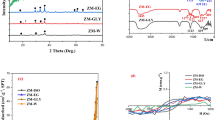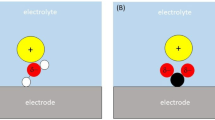Summary
A systematic comparative study of the adsorption and association of 3-methylxanthine (3MXan) and 7-methylxanthine (7MXan) at mercury-solution interfaces in acidic, neutral, and alkaline buffer solutions was undertaken by ac voltammetry. At bulk concentrations of3MXan above a threshold value, the stacking interactions between vertically oriented molecules lead to a slow reorientation aroundE ecm, and the molecules adopt a perpendicular orientation. The association of the adsorbed molecules of7MXan is hindered and is not effective in promoting base-base stacking interactions. The enhanced surface activity of3MXan compared to7MXan results from the different position of the methyl group in the purine moiety. The effect of some divalent metal ions on adsorption stages and association of the investigated compounds has been studied. The results indicate that the complexation of methylated xanthine enhances the stacking interactions and hence would be expected to facilitate the formation of perpendicularly stacked layers ofM(II)-MXan complexes on the electrode surface. The adsorption parameters of the investigated compounds have been computed in absence and presence of Cu(II) at differentpH values. The results are compared with the behaviour of xanthine.
Zusammenfassung
Eine systematische vergleichende Untersuchung zur Adsorption und Assoziation von 3-Methylxanthin (3MXan) und 7-Methylxanthin (7MXan) an Quecksilber-Lösungs-Grenzflächen wurde mittels AC-Voltammetrie in sauren, neutralen und basischen Pufferlösungen durchgeführt. Oberhalb einer bestimmten Grenzkonzentration kommt es durch Wechselwirkungen zwischen vertikal angeordneten3MXan-Molekülen zu einer langsamen Reorientierung umE ecm, was zu einer senkrechten Anordnung führt. Die Assoziation von7MXan ist gehindert und erlaubt daher keine ausgeprägten Basen-Basen-Wechselwirkungen. Die erhöhte Oberflächenaktivität von3MXan gegenüber7MXan resultiert aus der unterschiedlichen Stellung der Methylgruppe am Purinrest. Der Effekt einiger zweiwertiger Metallionen auf die Adsorption und Assoziation von3MXan und7MXan wurde untersucht. Die Ergebnisse weisen auf eine Begünstigung der Wechselwirkungen hin; die Bildung von vertikal angeordneten Grenzschichten an der Elektrodenoberfläche sollte daher im Fall vonM(II)-Mxan-Komplexen erleichtert sein. Die Adsorptionsparameter der untersuchten Verbindungen wurden in Abwesenheit und in Gegenwart von Cu(II) bei verschiedenenpH-Werten berechnet. Die Ergebnisse werden mit dem Verhalten von Xanthin verglichen.
Similar content being viewed by others
References
Taylor JB, Kennewell PD (1981) Introductory Medicinal Chemistry Ellis Horwood, New York
Betram G Katzung (1992) Basic and Clinical, Pharmacology, 5th edn. Appleon & Lange, Beirut
Goodman LS, Gilman A (1992) The pharmacological Basic of Therapeutics, chapter 25, vol 1. McGraw-Hill International Editions Medical series
Vetterl V (1966) Collect Czech Chem Commun31: 2105
Vetterl V (1968) Collect Czech Chem Commun34: 673
Vetterl V (1968) J Electroanal Chem19: 169
Janik B, Elving BJ (1968) Chem Rev68: 295
Barbec V, Christain SD, Kim MH, Dryhurst G, (1977) J Electroanal Chem85: 389
Kinoshita H, Christain SD, Dryhurst G, (1977) J Electroanal Chem85: 377
Baker JG, Christain SD, Kim MH, Dryhurst G (1979) Biophys Chem9: 355
Webb J, Janik B, Elving PJ (1973) J Am Chem Soc95: 991, 8495
Krznaric D, Valenta P, Nurnberg HW (1975): J Electroanal Chem65: 863
Valenta P, Nurnberg HW, Krznaric D (1976): Bioelectrochem Bioenerg3: 418
Vetterl V, Kovarikova E, Zaludova R (1977): Bioelectrochem Bioenerg4: 389
Temerk YM, Valenta P (1978) J Electroanal Chem93: 57
Temerk YM (1979) Can J Chem57: 1136
Temerk YM, Valenta P, Nurnberg HW (1980) J Electroanal Chem109: 289
Vetterl V, Pokorny J (1980) Bioelectrochem Bioenerg7: 517
Temerk YM, Kamal MM (1981) Bioelectrochem Bioenerg8: 671
Temerk YM, Kamal MM (1983) Bioelectrochem Bioenerg11: 457
Jursa J, Vetterl V (1984) Bioelectrochem Bioenerg12: 137
Kamal MM, Temerk YM, Ahmed ME, Ahmed ZA (1986) Bioelectrochem. Bioenerg16: 485
Temerk YM, Kamal MM, Ahmed ZA, Ibrahim MS (1989) J Electroanal Chem260: 201
Retter U, Vetterl V, Jehring H (1974) J Electroanal Chem57: 391
Retter U, (1978) J Electroanal Chem87: 181
Lippert B (1981) Inorg Chem20: 4326; Lusty JR, Chan HSO, Peeling J (1983) Transition Met Chem10: 930
Lippert B (1981) Inorg Chim Acta55: 5; Guay F, Beauchamp A (1982) Inorg Chim Acta66: 57
Kong PC, Rochon FD (1981) Can J Chem59: 3293
Speca AN, Pytlewski LL, Mikulaski CM, Karayannis NM (1982) Inorg Chim Acta66: 153
Beringhelli T, Freni M, Morazzoni F, Romiti P, Servida R, Spectrochem Acta, PartA:37: 763
Speca AN, Mikulski CM, Iaconianni FJ, Pytlewski LL, Karayannis NM (1981) J Inorg Nucl Chem43: 2771
Rosenberg B (1973) Naturwissenschaften60: 23
Aggarwal SK, Wanger RW, Meallister PK, Roserberg B (1975) Proc Natl Acad Sci USA72: 928
Ahmed ZA, Ahmed ME, Ibrahim MS, Kamal MM, Temerk YM (1994) Anal Chim Acta289: 329
Ahmed ME, Ibrahim MS, Temerk YM, Kawde AM (accepted for publication in Electrochimica Acta)
Temerk YM, Ahmed ME, Kamal MM (1984) Bioelectrochem Bioenerg12: 205
Christian SD, Dryhurst G, Barbec V, Baker JG (1977) J Colloid Interface Sci62: 454
Koryta J (1953) Collect Czech Chem DCommun18: 206, 208
Malfoy B, Sequaris JM, Valenta P, Nurnberg HW (1976) Bioelectrochem Bioenerg3: 440
Author information
Authors and Affiliations
Rights and permissions
About this article
Cite this article
Ahmed, M.E., Ibrahim, M.S., Temerk, Y.M. et al. Comparative studies on the adsorption and association of 3-methylxanthine and 7-methylxanthine at a charged interface. Monatsh Chem 127, 609–619 (1996). https://doi.org/10.1007/BF00817253
Received:
Accepted:
Issue Date:
DOI: https://doi.org/10.1007/BF00817253




